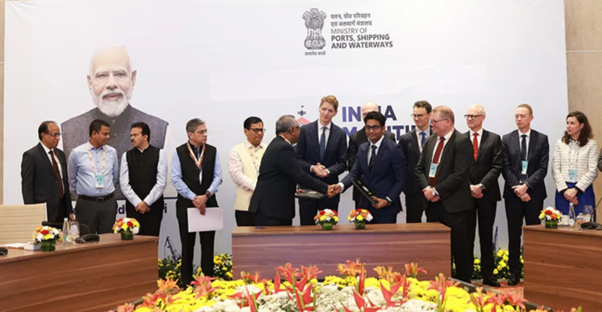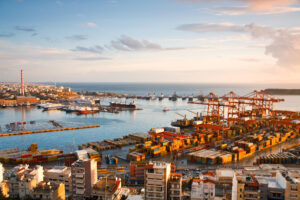
A.P. Moller-Maersk announced a series of strategic initiatives to strengthen its maritime ties with India during India Maritime Week 2025.
Maersk has unveiled a plan to expand its operational footprint in the country through port infrastructure investments, vessel reflagging, and enhanced local partnerships across the maritime value chain.
At the center of the strategy is a memorandum of understanding (MoU) signed between APM Terminals Pipavav (Gujarat Pipavav Port Limited), part of A.P. Moller – Maersk, and the Gujarat Maritime Board. The deal outlines a proposed expansion with an investment scope of $2bn (approximately ₹17,000 crore).
Subject to a long-term concession agreement with Indian authorities, the expansion will enhance the port’s capacity and capabilities with container and liquid cargo handling infrastructure, while strengthening multimodal connectivity with the Dedicated Freight Corridor and the national hinterland.
“This investment plan is not just about expanding Pipavav Port, it’s about unlocking new opportunities for Gujarat, for India, and for global trade,” said Jon Goldner, chief executive of APM Terminals Asia & Middle East. “Supporting the Hon’ble Prime Minister Shri Modiji’s vision, we are building the capacity, resilience, and sustainability needed to serve India’s economy for decades to come.”
As part of its strategy, Maersk has registered a new legal entity, Maersk Bharat IFSC Pvt. Ltd., at GIFT City IFSCA, Gujarat and flagged two vessels – Maersk Vigo and Maersk Vilnius – under the Indian flag.
The company is also deepening its collaborations with Indian shipyards for vessel repair and maintenance activities. Multiple MoUs have been signed with different yards to explore repair, maintenance, and new-building opportunities, establish capabilities that meet international operational standards, and create opportunities for knowledge transfer and skill development.
Additionally, Maersk said that it is exploring local manufacturing and the procurement of containers from Indian companies, working closely with partners to share technical specifications and quality requirements for procuring seaworthy containers, with the aim of establishing a domestic production roadmap.
“India possesses significant infrastructure capabilities that Maersk wishes to capitalise on,” noted Ahmed Hassan, head of asset strategy at A.P. Moller-Maersk. “By flagging vessels under the Indian flag, manufacturing seaworthy containers in India and engaging local yards for maintenance and repair work, we’re not just expanding our operational flexibility; we’re investing in the development of India’s maritime ecosystem and demonstrating our belief in the country’s technical capabilities.”
Meanwhile, Maersk is partnering with educational institutes and organisations focused on skill development in the maritime sector, providing onboard training opportunities to maritime cadets and ratings.


